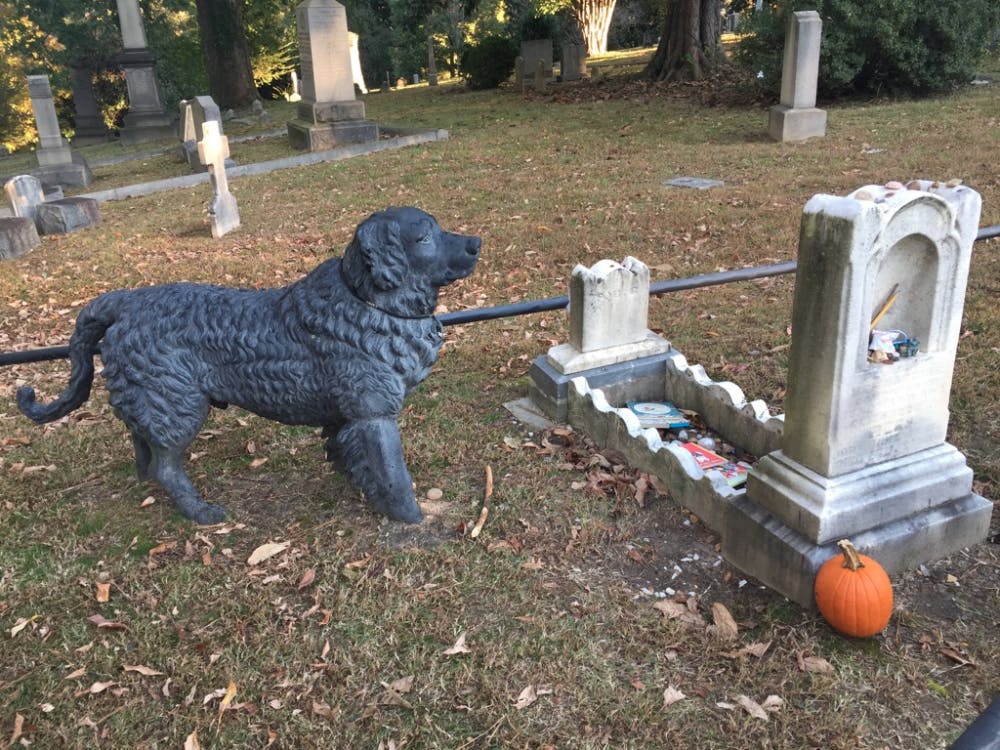A cast-iron Newfoundland dog stands guard over the grave of a toddler who died in 1862 at the Hollywood Cemetery in Richmond.
The story goes that the dog was almost melted for iron to be used by the Confederates during the Civil War, but when the little girl died, the dog was placed by her grave because she loved playing with the statue. Visiting this grave is almost eerie because although it is faded and worn with age, the grave itself is littered with shiny children’s books and toys that people leave for the girl to this day.
Spooked yet?
Perhaps not, but maybe riding a bike through the 138-acre cemetery on Halloween night might sound more tempting to those looking for a Halloween activity.
The Outdoor Adventure and Recreation program at the University of Richmond created an event that would do exactly that, but there was only one problem: Nobody signed up.
OAR adventure and leadership manager Lee Donlon said OAR created the event to give students an alternative way to celebrate Halloween.
“It was going to be a fun and safe way to celebrate Halloween,” Donlon said. “It would expose people to an interesting part of Richmond.”
Donlon cited the timing of the holiday as well as lack of awareness for being probable causes for the event’s collapse.
“Halloween is midweek,” Donlon said. “Also, SpiderBytes aren’t going out – I don’t think we’re as visible as we once were.”
Although the event is no longer taking place, students such as senior Emma Slevin recommend that others eventually make the trip to the cemetery.
Slevin visited for a biology class during the summer of her sophomore year. The class went to try to find names of about 20 people who died in different decades. Her classmate at the time, senior Ana Ramirez, also commented on her surprising enjoyment of the visit and the beauty of the cemetery.
"I think it's a really cool place," Slevin said. "It's kind of spooky."
Enjoy what you're reading?
Signup for our newsletter
When told about the OAR event, Slevin said it sounded like a fun activity. Her only reservations were about the biking.
"That's really cool," Slevin said. "But I think it's really hilly. People would struggle."
Other proponents of visiting the cemetery include Jane Keyser, a guide for The Valentine, a museum in Richmond that offers tours of the cemetery.
Although Keyser is not a tour guide for the cemetery in particular, she has ample knowledge of the history behind the site.
“In the South, most cemeteries were either family plots on farms, or they were like the plot around St. John’s Church up in Church Hill,” Keyser said. “But as your population gets denser, that’s not going to work very well.”
The Hollywood Cemetery was a part of the movement to create public park-like cemeteries, Keyser said. When the first burial occurred in 1849, the cemetery was not yet thriving.
“It was built as a for-profit kind of thing,” Keyser said. “It was not doing very well, financially, until President Monroe was buried there.”
Monroe’s grave, built in 1858, is one of the most popular sites at the cemetery because of the unique construction of his sand-stone colored tomb. In fact, it is also a National Historic Landmark for its unique architectural design.
“President Monroe’s grave looks like a giant bird cage,” Keyser said. “But it’s painted to look like carved Gothic tracery, like you’d see in a Gothic cathedral. It’s just really, really phenomenal.”
Another famous attraction at Hollywood Cemetery is the 90-foot tall granite pyramid commemorating fallen Confederate soldiers. Keyser said this monument had been constructed, in part, by a nearby prisoner who would leave prison without a guard on a work-release type of deal to go construct the pyramid.
Other notable people who are buried in the cemetery include Confederate President Jefferson Davis, President John Tyler, several historical figures from the Confederate side of the Civil War and six governors of Virginia.
Also worth noting is the fact that the cemetery is famous not only for its graves and monuments, but also for its trees. Recognized as an arboretum in 2017, Hollywood Cemetery is home to over 2,000 trees.
All things considered, Keyser said the trip to the cemetery would be worthwhile, but not necessarily in the spirit of today’s Halloween. She did, however, talk about the history of Halloween and said some people in other countries would probably value visiting the cemetery on Halloween more than Americans would, given the differences in our Halloween celebrations.
“Halloween now is kind of just this funny trick-or-treat thing,” Keyser said. “But in Mexico and in most of Catholic Europe, Halloween is not a trick-or-treat thing. They go to the grave, and they clean up the family grave. They frequently have a picnic in the family plot and tell the grandkids stories about great-grandmother and tell kind of the family history while the children eat sugar candies shaped like skulls in Mexico.”
Keyser said the cemetery was a great way to consider the contextualization of history– both for recognizable figures and on smaller scales. One example she had for contextualizing history was with an old, random plot within the cemetery where a whole family was buried, although for about 30 years one of the bodies did not have a headstone. The rest had tombstones that were shaped like intricate partial tree stumps. Eventually, the man was given a plain slab of a headstone next to all the elaborate ones. The story behind this is that the man had abandoned his wife and children to run away with his girlfriend and, reasonably so, caused considerable controversy within the family.
“It’s the same kind of stuff that families go through now,” Keyser said.
A security officer from the cemetery, who asked to be unnamed, added his own thoughts on why students should make the trip and visit.
“It’s very well maintained," he said. "It’s no charge. It’s very educational. The history of the U.S. is here.”
He added that this cemetery is full of old graves but that its expansive nature means there is still room for more. The only catch is that it can cost upwards of $40,000 to buy a lot today.
“I’d rather buy a new Harley,” the officer said.
Reporter’s note: I did in fact bike around the cemetery to see many of its noteworthy sites. It was beautiful, but beware that the bike ride is, admittedly, fairly hilly. If you would like to try the ride on your own, there is a RVA Bike Share station right outside the opening gates of the cemetery, and the first 45 minutes of the bike ride are free.
Contact co-features editor Abby Seaberg at abigail.seaberg@richmond.edu.
Support independent student media
You can make a tax-deductible donation by clicking the button below, which takes you to our secure PayPal account. The page is set up to receive contributions in whatever amount you designate. We look forward to using the money we raise to further our mission of providing honest and accurate information to students, faculty, staff, alumni and others in the general public.
Donate Now



